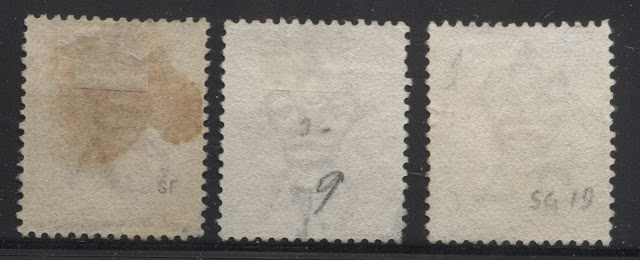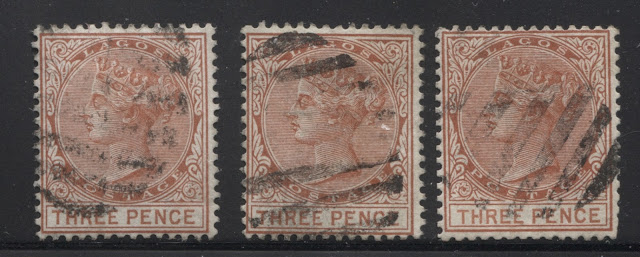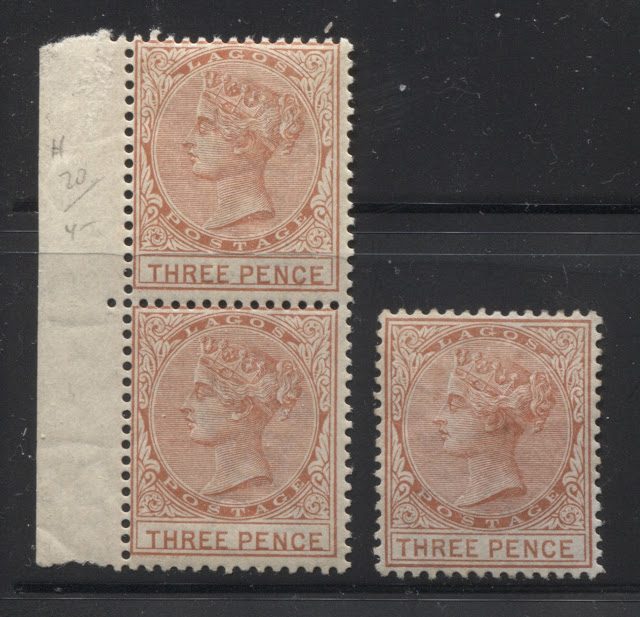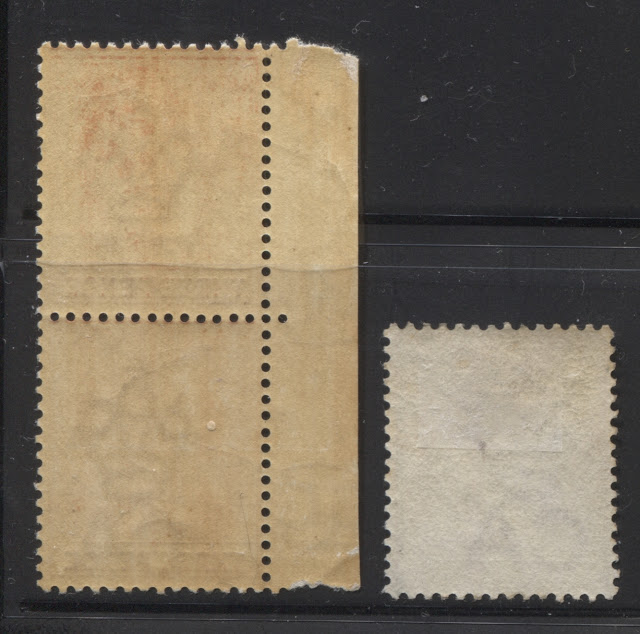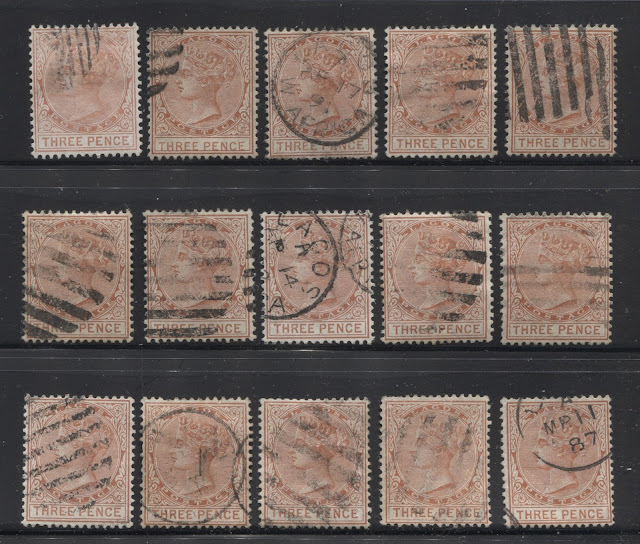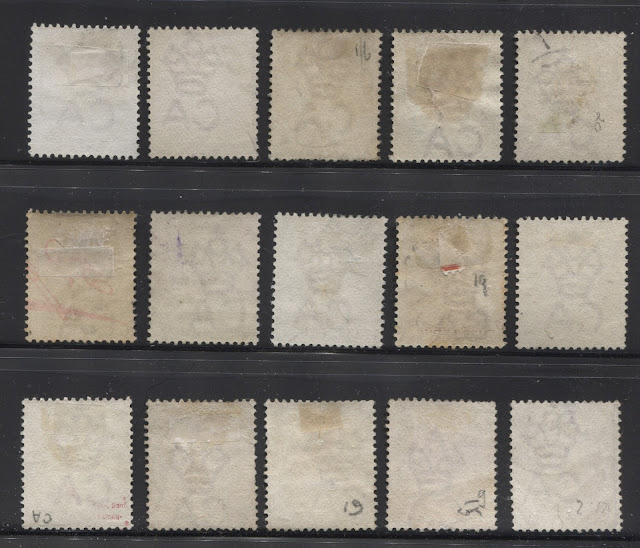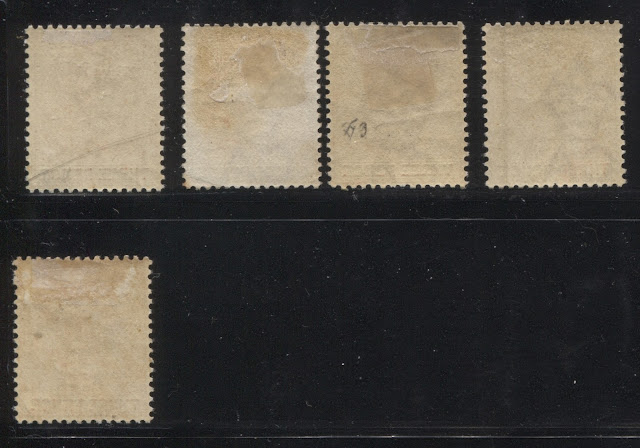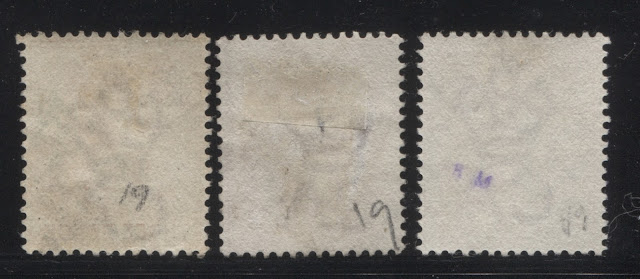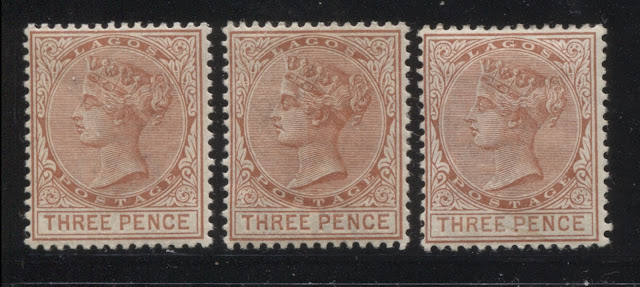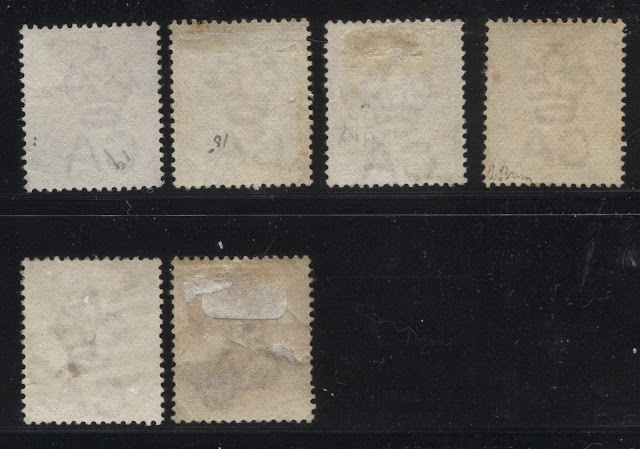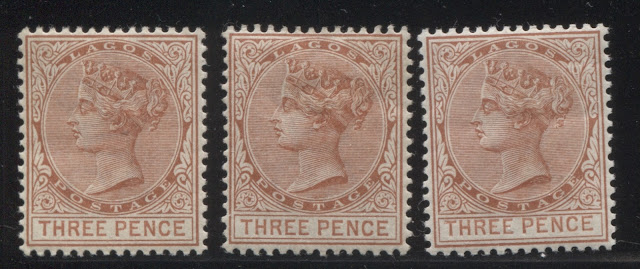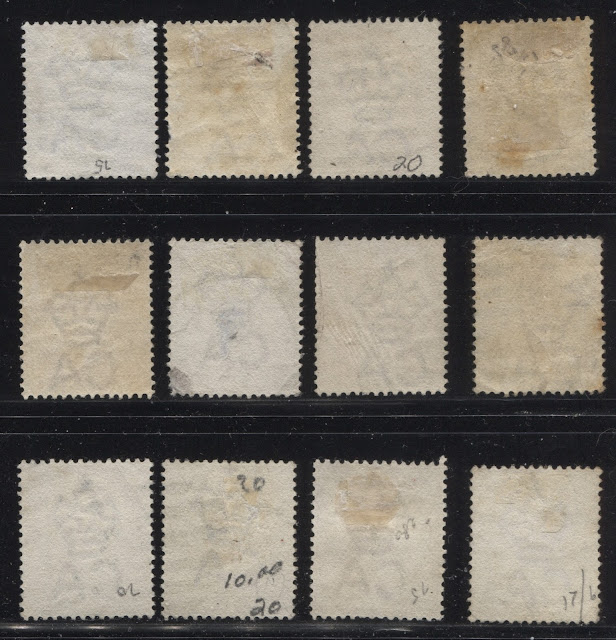In today's post, I will look at the printings of the 3d chestnut stamp from the first crown-CA issue. This stamp had the unique distinction of not being replaced by the stamps of the second crown CA Issue between 1884 and 1886. In fact, it was not until 1890 when the bicoloured mauve and chestnut stamp was first dispatched, that this stamp was replaced. Therefore, it is not unheard of to see this stamp with cancellations dated into the early 1890's.
Ince did list four printings made during the period of the second crown CA issue, between 1884 and 1886, which comprised 17,820 of the 24,540 stamps that were printed. Those printings were as follows:
That left 6,720 stamps that would have been printed between February 1882, when the stamps were first issued, and December 1884 - a period just under 3 years. The question is: how many printings were made in this three year period? By looking the quantities of the known printings, you can see that the quantities produced with each shipment were between 3,360 and 3,600 stamps. So it seems likely that the 6,720 stamps produced prior to 1884 were produced in two, or possibly three smaller printings. There was about 6 months between each of the known printings, so assuming that this interval was consistent throughout the period, and taking into account the fact that the very first printings were not placed on sale until June 1882, then there should have been 4 printings as follows:
Ince did list four printings made during the period of the second crown CA issue, between 1884 and 1886, which comprised 17,820 of the 24,540 stamps that were printed. Those printings were as follows:
- July 8, 1884 - 56 sheets
- December 16, 1884 - 60 sheets.
- July 13, 1885 - 63 sheets.
- December 29, 1885 - 60 sheets
- June 30, 1886 - 58 sheets
That left 6,720 stamps that would have been printed between February 1882, when the stamps were first issued, and December 1884 - a period just under 3 years. The question is: how many printings were made in this three year period? By looking the quantities of the known printings, you can see that the quantities produced with each shipment were between 3,360 and 3,600 stamps. So it seems likely that the 6,720 stamps produced prior to 1884 were produced in two, or possibly three smaller printings. There was about 6 months between each of the known printings, so assuming that this interval was consistent throughout the period, and taking into account the fact that the very first printings were not placed on sale until June 1882, then there should have been 4 printings as follows:
- February 14, 1882.
- December 1882 or January 1883.
- June 1883 or July 1883.
- December 1883 or January 1884.
However, if there were four printings during this period, it would mean that each one was only about half the size of the printings made after July 1884. This would make sense only if there was an event occuring in the early 1880's that increased the demand for 3d stamps. I do not know of any such event, but it is possible that the demand for the 3d did increase.
In sorting the different printings, I am fortunate to have, at my disposal, many more stamps: 25 mint examples and 45 used examples! It should be borne in mind that all shipments after April 1886 from the Crown Agents to Lagos were double gummed, owing to complaints that had been received by them of stamps having insufficient gum. Thus the last printing made in June 1886 should be double gummed, and very easy to distinguish from the others. As discussed in the earlier posts dealing with the 1d and 2d values, the 1882 and 1883 gum should be crackly, even when examined in normal light without a loupe, whereas after 1883, the gum becomes much smoother and closer to the toned gum found on the second crown CA issue.
CDS dated Lagos cancellations are quite a bit more common during the early 1890's and late 1880's, and these should be helpful in identifying examples of the later printings. Despite the fact that the 8-bar oval killers were still the predominant cancel during this period, most used examples of this stamp will be found with the later 9-bar type with the thinner bars. This is helpful in the sense that where we find a printing that is cancelled by predominantly 8-bar cancels, we can reasonably assume that it is an earlier printing than the ones with predominantly 9-bar types.
My approach in attempting to sort these will be to start with the colours of the head plate and duty plate, looking for differences in shade, and then to look at the paper and gum differences. The earlier printings should be on paper that shows a faint vertical mesh and very visible watermark, while the later printings are on paper that shows no obvious mesh and watermarks that are much harder to see without watermark fluid. I will proceed on the assumption that there were indeed 9 printings, and be open to the possibility of fewer than 9 - possibly as few as seven. Once I have them sorted into what I think are the different printings, I will attempt to assign them to the various dates.
Printings Identified
As it turns out, I did identify nine different groupings of printings. Five of these had both mint and used examples, while the other four had either all mint, or all used examples only. As we shall see the name "chestnut"to describe the colour is a bit of an oversimplification. There are quite a few printings where the colour is closer to Indian red, which is a variation of Terracotta, while the later printings are either lake-brown or chestnut. As per usual with these stamps, on some printings we see a high degree of uniformity between the head plate and duty plate (words "three pence") colours, while on other printings, the colours are as different as night and day.
So without further ado, here is what I have identified:
Group 1 - First Printing Dispatched February 14, 1882
The first group I have identified by the fact that it is the only example with a specimen overprint in manuscript. It would seem to be reasonable to assume that the specimens would have come from the first printings, and not the later ones, as by then the member nations would have seen an example of the current stamps. I have only four mint examples, and no used ones. This is consistent with the expectation that any stamps from these first four printings should be much, much scarcer than the later five printings.
Here are the four mint examples in my stock as seen from the front:
As you can see from the scan, there is no significant difference between the duty plate and head plate colours. Under a loupe you may be able to see a very slight difference, however, the general shade of this printing is an almost perfect match to the Indian red swatch of the Stanley Gibbons colour key.
The gum on this printing has the yellowish colour and slight crackliness that is consistent with the very last printings made during the crown-CC period. So this is consistent with the classification of this printing as the first one. Here is a scan showing the back of the above stamps:
The crackliness of the gum is difficult to see from this scan, but it is present, and is quite fine. Note that on these stamps that the vertical mesh is not clearly visible, nor is the watermark that clear without the aid of a watermark detector.
Group 2 - Second Printing - Likely Dispatched Between December 1882 and January 1883
Like the first group, mint examples from the second group also have crackly gum. In addition, while the cancellations on the three used stamps are not distinct, they do not appear to be the later 9-bar types. Finally, the colour is close to the first group. So on this basis, I have classified this group as the second printing. The colour of the duty plate is lighter than the head plate, and what is particularly striking is that the letters of "three pence" appear thin and weak compared to the other printings. Both the head and duty plate colours are lighter than the Indian red swatch, but just a touch more orange compared to the chestnut swatch of the Gibbons colour key. The colour is more what you would expect if you blended the Indian red and chestut swatches and then took the resulting colour and lightened it just a bit by adding white. Here is a scan of the three mint examples to show you what I mean:
Notice how the colour is not as orangy as the stamps in the first group, and also note how pale the lettering of "three pence" is in relation to the rest of the design. Let's take a look at the backs:
Only the second stamp shown here really has what could be called full original gum. However, even from the scan, you can see that it is crackly. The vertical mesh is not visible on this second stamp, however, it is just visible on the other stamps, which supports the notion that this is an earlier printing.
Now here are the three used examples that I have:
These cancels appear to be the older 8-bar types, though it is difficult to be certain. However, the lack of both CDS and the later 9-bar types, as well as the relatively low number of examples in my stock supports the notion that these are from one of the earliest printings.
Here is the back of these three stamps:
Here we can just make out faint vertical mesh, as well, as faint watermarks, which again is consistent with these being from printings made in the early 1880's.
Group 3 - Third Printing - Likely Dispatched Between June 1883 and July 1883
In this group I only have three used examples. The most striking feature of the stamps from this printing is that the head plate colour is chestnut, while the duty plate colour is a rich shade of lake brown. It is very distinct, being completely different from any other printing. The stamps of this group could just as easily be from the fourth printing. My reason for classifying them thus, is based on the similarity of the head plate colour to the first two printings. Two of the three stamps are cancelled with the older 8-bar type, while the third stamp bears a November 1886 Lagos CDS postmark. Bear in mind that late dates on the stamps of Lagos are not that uncommon, as it was possible for a small quantity of stamps from an earlier printing to be buried under a new, fresh supply of stamps, so that the earlier ones would not get sold at the post office until the supply was well and truly exhausted.
Here is a scan of these three used stamps:
Note how strikingly dark the words "three pence" are as compared to the rest of the design.
Now, let's take a look at the backs:
Once again, all three stamps show clear vertical mesh ans clearly visible watermarks, which is consistent with their classification as earlier printings.
Group 4 - Fourth Printing - Likely Dispatched Between December 1883 and January 1884
I also do not have any mint examples of the stamps in this group, and once again, I have just three used examples. Like the third group above, there are no 9-bar cancellations to be found. All three of these stamps are cancelled with the earlier 8-bar types. The colour of both the head plate and the duty plate is lake brown, rather than chestnut, or Indian red, making it just as distinct a printing as the stamps of the third group. I classified these as the fourth printing because their entire colour is similar to the duty plate colour of the last printing. However, it is entirely possible that the other stamps above are the fourth printing, while these ones are the third.
Here is a front scan of these three stamps:
Note how deep, rich and vibrant the colour is compared with the other printings, and how it is consistent across the stamp.
Now let's see if the paper shows the same vertical mesh as the other early printings:
As you can see, vertical mesh is present on all three stamps, though it is not as obvious on the right stamp. This, along with the cancels supports their classification as an early printing
To this point, out of 70 stamps in my stock, only 17 are from these first four printings. This is entirely what we would expect, given that these first four printings accounted for only about 25% of the total number of stamps printed.
Group 5 - Fifth Printing - Dispatched July 8, 1884
This printing was a bit problematic, as the only mint pair that I have, had gum that was toned and a bit crackly, which suggests an early to mid printing. However, the sheer number of used singles in this group (15 out of the 45 used stamps) coupled with the large number of late 9-bar cancels and late dated CDS's indicates that it must be from the later printings. The gum on the mint pair tends to suggest that of the later pritings that this group can be from, it must be from the earliest of these, and that would be the fifth printing that was sent on July 8 1884.
The stamps of this group are the same general tone as the first printings, Indian red. However, the shade is lighter than the pure Indian red. The duty plate and the head plate are both the same shade.
Here is the mint pair and one re-gummed mint single:
As you can see, the colour is orangy, which is what makes them Indian red, rather than chestnut.
Now, let's take a look at the gum:
Here you can see the toned gum, which is common on printings made between 1884 and 1886. The stamp on the right has a thick, shiny, colourless gum which is quite unlike anything normally found on these issues. This leads me to believe that it is not the original gum.
Now here are the 15 used examples:
Of the 15 stamps shown above:
- 1 is cancelled with a foreign grid cancel of some kind which is not native to Lagos.
- 7 are cancelled with the 8-bar oval killer.
- 1 is cancelled with either an 8-bar or a 9-bar killer.
- 2 are cancelled with a 9-bar oval killer.
- 4 are canceled with Lagos CDS's dated between March 1887 and April 1892.
So these are definitely from a printing sent after 1883, but still relatively early in the sequence of printings after 1883.
The backs should reveal some papers showing clear watermarks and faint mesh, and other stamps showing no visible mesh and watermarks that are not entirely clear. Let's see now if this is in fact the case:
The backs do show what we expected, with a few of the stamps, most notably in the top row having the clear vertical mesh and highly visible watermarks. However, most of the stamps are printed on paper that does not show the watermark as clearly, and which does not have clearly visible mesh.
Group 6 - Sixth Printing - Dispatched December 16, 1884
On this printing, the gum begins to take on the smoother appearance that is characteristic of the later crown CA period. The shade is almost exactly identical to that of the first printing: a pure Indian red. Again, the head plate and duty plate colours are very close, but under a loupe, you will see that the duty plate is a little less orange, and a little closer to chestnut than the head plate colour. I have three used examples and all three are cancelled with a 9-bar oval killer. My classification of these stamps as the sixth printing, rather than the seventh, eighth or ninth, rests on my observation that the gum on two of the mint examples shows a very slight crackliness, whereas all the other mint stamps from here on in have smooth gum. Furthermore, these stamps are not double gummed, so they cannot be from the ninth printing.
Here are the five mint examples that I have:
Note the similarity between the colour of these stamps, and those of the first printing. Now here is what the gum looks like:
Here the gum is smoother than the gum from the first printings.
Now, here are my three used examples showing the clear 9-bar oval killer postmarks:
One question, you might have is: how can you tell if the cancel is 8 bars or 9 if the some portion of the cancel is not visible? The easiest way is to remember that:
- An 8-bar killer consists of three bars of gradually increasing width, then 2 bars of equal width followed by the 3 more bars of the same widths as the first three.
- A 9-bar killer consists of four bars of gradually increasing width, then one widest middle bar, and then 4 more bars just like the first four.
So, if you can see one entire end of the postmark up to the middle bar, you can tell how many bars in total there re likely to be. Here, these are clearly the later 9-bar types, which suggests this as being one of the later printings.
Lets see what the paper looks like on the backs:
Both the mesh, and the watermark is faint on all three stamps, which suggests that these are one of the late printings.
Group 7 - Seventh Printing - Dispatched July 13, 1885
The stamps of this printing are chestnut, with just a hint of orange, but not enough to make it Indian red. The duty plate shade, under a loupe is just a touch lighter, but to the naked eye they are both the same colour. The gum on two of my three mint examples is perfectly smooth, while the third example has just hint of crackliness. The postmarks found on the used examples that I have appear to be mostly 9-bar types, with maybe 1 or 2 8-bar types. Once again, the gum is not a double layer, so it cannot be the last printing. Finally, the fact that one mint stamp still has slightly crackly gum suggests to me that this is not the eighth printing either.
Here are the three mint examples:
Hopefully you can see that there is definitely less orange and more brown in this shade, which brings it much closer to true chestnut than the other printings.
Now, let's see the gum:
The gum is smooth, but all three stamps show clear vertical mesh, which tends to suggest an earlier printing. However all other characteristics support its classification as a later printing.
Here are the used stamps from this printing:
Note how most of these are 9-bar cancels. Only the stamp at the top right and the second stamp from the left on the bottom row have a chance of being 8-bar types. I would expect that very few if any of these will show clear vertical mesh on the back:
Here some of the stamps do show faint vertical mesh, while others do not. However, the shades and cancels suggest that they are all from this printing.
Group 8 - Eighth Printing - Dispatched December 29, 1885
For this printing I have only three mint examples. The gum on all three of these is completely smooth and toned, which suggests that it they are from one of the last printings. The gum is not double, so they cannot be the last printing. The colour on these three stamps is closest to a pure chestnut, being deeper than the last printing, and less orange. The duty plate colour is every so slightly lighter, but you have to look very, very closely to see any difference at all.
Here are these three stamps:
If you compare this colour to the first pritings for example, you can see that there is much less orange in the colour of these stamps.
Now, let's take a look at the gum:
The gum on these has a light cream tone, and is completely smooth. There is faint vertical mesh visible on all three stamps. So it would appear that the visibility of the mesh does not play that much of a role in differentiating the printings they way that it does with some of the other denominations. This is because stamps all the way up to the last printing can be found with clear mesh, while other stamps do not show any, and there appears to be not pattern as to which stamps do show mesh and which ones do not.
Group 9 - Ninth Printing - Dispatched June 30, 1886
I have identified this last printing on the strength of four mint examples, two of which are so heavily gummed, that they curled on my desk, when the other stamps all laid flat. This suggests to me that these are examples of the double gummed stamps that were sent after April 1886. The colour this time is a lighter chestnut, and the head and duty plate colours are again very similar. This group is very similar in appearance to the fifth printing. The main difference is that these stamps are light chestnut, whereas the stamps of group 5 were light Indian red, containing more orange in the mix. I have 12 used examples, which bear a variety of different cancels.
Here are the four mint examples:
You should be able to see that this colour is quite a bit paler than the last group.
Here is the double gum:
The thickness of the gum is particularly prevalent on the left stamp. Interestingly, none of these stamps show clear mesh, nor are the watermarks particularly clear.
Let's look now at the 12 used stamps:
So basically one-third of the stamps above are cancelled with a CDS, and all of these are dated between July 1888 and December 1891, while half of the rest are cancelled with 8-bar types, ad the other half with 9-bar types. So classifying these as the last printings does not appear to be out of line at all.
Let's conclude with a look at the backs:
None of these stamps show obvious mesh on the back, which is consistent with the mint stamps.
That concludes my examination of the 3d chestnut. Next week, I will look at the last stamp from this series, the 4d rose. Then I will start to look at the second crown CA issue, when the colours were changed to comply with U.P.U regulations.







